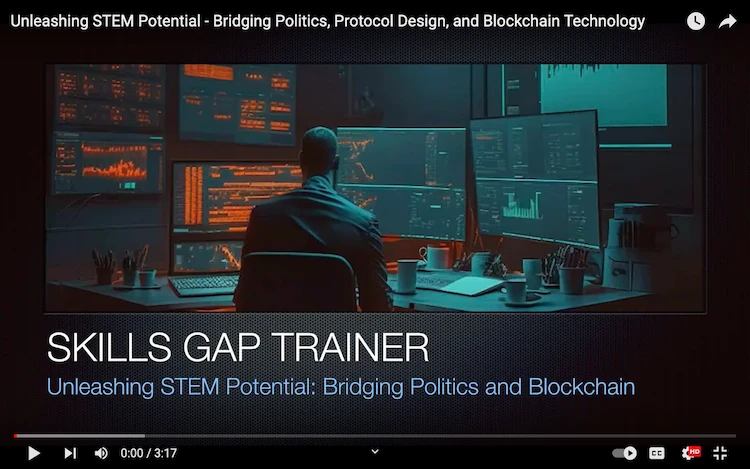In light of Charles Hoskinson’s discourse on the intersection of politics, protocol design, and cryptocurrency, it is essential to delve into the repercussions of these interactions within the context of computer science, software engineering, blockchain development, project management, and beyond.
Historically, we’ve seen software systems designed with a veil of opacity, leading to inefficiencies and misalignment with the diverse needs of our natural world, society, and various sectors like finance, business, and industry. This observation holds even more weight when we consider the potential of blockchain and cryptocurrencies, technologies inherently designed for transparency and decentralization.
The point around the 5-minute mark in Hoskinson’s discussion is a prime example of this. Engineers, technologists, and computer scientists have often circumvented the complex world of politics, adhering instead to established frameworks and protocols. While this approach may have proven successful in catering to the needs of corporations and political entities, it often overlooks the essential facets of our natural world, engineering principles, scientific standards, and human society.
STEM professionals — given their expertise in understanding complex systems, problem-solving abilities, and technical prowess — should indeed play a central role in designing both our natural and virtual worlds. Their proficiency can influence the design of protocols and governance models that align better with scientific principles and societal needs.
Contemporary issues, such as inefficiently engineered systems and the obscurity shrouding online applications’ operations, bear testament to this need. Creating a secure, trustworthy solution necessitates a departure from such obfuscation towards more transparent, efficient models. Blockchain technology, with its emphasis on transparency, security, and decentralization, offers one such solution.
As discussed in our recent article for Skills Gap Trainer, “Beyond Apps and Smartphones: Unleashing STEM Potential for a Sustainable, Resilient Future,” we need to empower STEM professionals to step into roles of governance and decision-making. By harnessing their unique skills and perspectives, we can not only design more efficient and secure systems but also cultivate a future that is sustainable and resilient, mirroring the principles of STEM fields.
In sum, by intertwining politics, protocol design, and emerging technologies like blockchain, we can create a more enriched, efficient universe that better caters to the myriad needs of society. By placing STEM professionals at the forefront of such efforts, we can truly unleash the potential to build a sustainable, resilient future.
Related content:
@PierrePoilievreTitle: “Blockchain for Public Trust: A Path to Complete Transparency in Canadian Government Spending”
1. Implementing a Blockchain-Based Government Spending Platform:
- Standardization of Financial Data: Unified Reporting Format: Adopt a standardized digital format for all government spending records across departments and agencies.
- Real-Time Data Entry:Implement systems that allow for immediate recording of transactions to enhance transparency and reduce the risk of data manipulation.
2. Blockchain Integration:
- Selecting a Suitable Platform: Choose a blockchain technology that offers scalability, security, and transparency, such as Ethereum or Hyperledger.
- Immutable Record Keeping:Utilize blockchain’s decentralized ledger to ensure all transactions are permanently recorded and tamper-proof.
- Smart Contracts:Employ smart contracts to automate compliance checks and flag any anomalies in spending patterns.
3. Public Accessibility:
- User-Friendly Interfaces:Develop web portals and mobile applications that allow citizens to access and analyze government spending data easily.
- Open Data Formats:Provide data in accessible formats (e.g., CSV, JSON) to facilitate public analysis and third-party app development.
4. Legal and Regulatory Framework:
- Legislative Support: Enact laws that mandate the recording of all government spending on the blockchain to ensure compliance across all levels of government.
- Privacy Considerations:Protect sensitive information by anonymizing personal data while maintaining transparency of transaction details.
- Oversight and Auditing: Establish independent bodies to monitor the blockchain records and ensure adherence to reporting standards.
5. Pilot Implementation and Scaling:
- Initial Pilot Programs: Begin with specific departments or projects to test the system’s effectiveness and address any technical challenges.
- Evaluation and Expansion:Use feedback from the pilot to refine the system before scaling it to encompass all government spending.
6. Public Engagement and Education:
- Awareness Campaigns: Educate the public about the new system and how they can participate in monitoring government spending.
- Stakeholder Collaboration:Engage with technology experts, transparency advocates, and civil society organizations to continuously improve the system.
Benefits of the Blockchain Approach:
- Enhanced Transparency:An open ledger accessible to all Canadians increases trust in government operations.
- Improved Accountability:Government officials and agencies are held responsible for their financial decisions.
- Efficiency and Integrity:Reduces opportunities for mismanagement of funds and ensures that public resources are used effectively.
- Innovation and Leadership: Positions Canada as a global leader in leveraging technology for transparent governance. By adopting this blockchain-based solution, Canada can create a more transparent and accountable government, ensuring that public funds are managed responsibly and effectively for the benefit of all citizens.

Related books and resources:
“Blockchain Revolution: How the Technology Behind Bitcoin and Other Cryptocurrencies is Changing the World” by Don Tapscott and Alex Tapscott: This book offers a comprehensive exploration of how blockchain technology can revolutionize business, government, and society.
“The Age of Cryptocurrency: How Bitcoin and the Blockchain Are Challenging the Global Economic Order” by Paul Vigna and Michael J. Casey: Provides insight into how cryptocurrency is changing the financial world and its potential to disrupt traditional banking and monetary systems.
“The Infinite Machine: How an Army of Crypto-hackers Is Building the Next Internet with Ethereum” by Camila Russo: Chronicles the development of Ethereum and provides context for understanding how blockchain can be used beyond cryptocurrency.
“Mastering Blockchain: Unlocking the Power of Cryptocurrencies, Smart Contracts, and Decentralized Applications” by Imran Bashir: An in-depth guide to the technical concepts behind blockchain, suitable for IT professionals and enthusiasts.
“Digital Gold: Bitcoin and the Inside Story of the Misfits and Millionaires Trying to Reinvent Money” by Nathaniel Popper: Narrates the history of Bitcoin and the characters involved in its creation, providing background on the development of cryptocurrency.
“Cryptoeconomics: Fundamental Principles of Bitcoin” by Eric Voskuil: Offers an in-depth discussion of the economic principles underlying Bitcoin and blockchain technology.
“Politics of Blockchain: The Technology of Disruption and Its Impact on Our Societal Structures” by Anthony Day: This book examines the intersection of blockchain technology with politics and how it can lead to decentralization in various sectors.
“Decentralized Applications: Harnessing Bitcoin’s Blockchain Technology” by Siraj Raval: Explains how decentralized applications are built upon blockchain technology, offering insights relevant to developers and technologists.
“Smart Contracts: The Essential Guide to Using Blockchain Smart Contracts for Cryptocurrency Exchange” by Jeff Reed: Focuses on the use of smart contracts in the blockchain space, relevant for understanding protocol design.
“The Truth Machine: The Blockchain and the Future of Everything” by Michael J. Casey and Paul Vigna: Provides a broader view of the potential applications of blockchain technology and its impact on society.
To see our Donate Page, click https://skillsgaptrainer.com/donate
To see our Instagram Channel, click https://www.instagram.com/skillsgaptrainer/
To see some of our Udemy Courses, click SGT Udemy Page
To see our YouTube Channel, click https://www.youtube.com/@skillsgaptrainer

